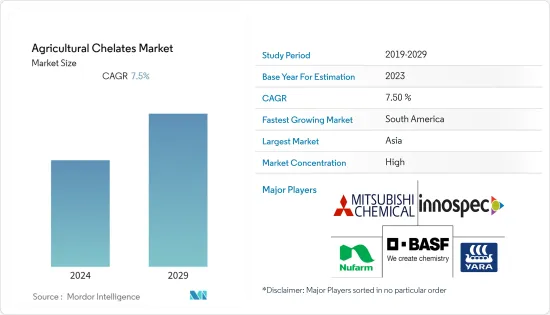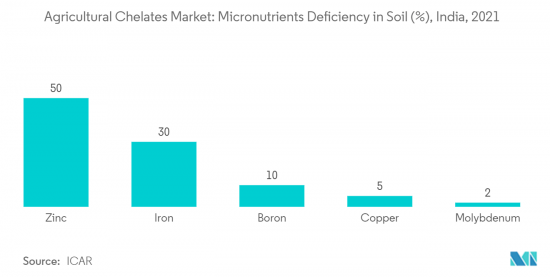 |
市場調査レポート
商品コード
1402967
農業用キレート化合物の市場シェア分析、産業動向と統計、2024~2029年の成長予測Agricultural Chelates - Market Share Analysis, Industry Trends & Statistics, Growth Forecasts 2024 - 2029 |
||||||
● お客様のご希望に応じて、既存データの加工や未掲載情報(例:国別セグメント)の追加などの対応が可能です。 詳細はお問い合わせください。
| 農業用キレート化合物の市場シェア分析、産業動向と統計、2024~2029年の成長予測 |
|
出版日: 2024年01月04日
発行: Mordor Intelligence
ページ情報: 英文 120 Pages
納期: 2~3営業日
|
- 全表示
- 概要
- 目次
農業用キレート市場は2024年に11億米ドルとなり、予測期間中のCAGRは7.5%と予測されます。

主要ハイライト
- 気候条件の変化、耕作可能地の減少、世界人口の増加により、食糧安全保障に対する懸念が高まっています。その結果、作物の収量を向上させ、世界の食糧需要を満たすために、農業分野でのキレートの使用が大幅に増加しています。キレートは、特定の栄養素を利用可能にすることで、植物の栄養吸収を改善するのに役立ちます。このプロセスにより、植物の成長と発育が改善され、作物の収量と品質が向上します。
- 土壌は不均質で複雑であるため、従来の微量栄養素は容易に酸化または沈殿してしまいます。キレート化によって、微量栄養素は溶液中や土壌中で望ましくない反応を起こさずに済みます。キレート化肥料は、Fe、Cu、Mn、Znなどの微量栄養素の生物学的利用能を向上させ、ひいては商業作物生産の生産性と収益性に貢献します。作物が低微量栄養素ストレスやpH6.5以上の土壌で栽培されている場合、キレート肥料は通常の微量栄養素よりも商業的収量を増加させる可能性があります。
- 持続可能な農業の台頭と、合成キレートが環境に与える悪影響に対する意識の高まりに伴い、生分解性キレートの需要が増加しています。そのため、各社は顧客のニーズを活用し、市場で主導的な地位を維持しています。
- 例えば、米国を拠点とする特殊化学品メーカーのInnospecは、2022年に生分解性キレートENVIOMET(R) Cを発売しました。ENVIOMET(R) Cキレートは、環境中に放出されると速やかに生分解し、鉛(Pb)などの重金属と難分解性の有機キレートを形成する可能性を低減します。その結果、土壌蓄積や地下水汚染のリスクが少なくなります。
- したがって、上記の要因が調査期間中の市場成長を刺激すると予想されます。
農業用キレートの市場動向
農業におけるEDTAの選好の高まり
- エチレンジアミン四酢酸(EDTA)は、農業で最も広く使用されている合成キレートの1つであり、土壌や葉面散布の栄養剤に応用されています。EDTAは、pH6.0の土壌の場合、露地施肥にも使用できます。EDTAが最大の市場シェアを占める背景には、その幅広い用途があります。
- EDTAキレートは、鉄(Fe)、マンガン(Mn)、銅(Cu)、亜鉛(Zn)などの微量要素を土壌から植物の根に取り込むのに有効であるため、他の無機源よりも広く好まれています。
- 微量栄養素である亜鉛は、植物ホルモンのバランスとオーキシン活性に重要であり、植物の成長に不可欠です。Zn-EDTA(Znの12%)のような有機キレート化亜鉛源は、一般に無機亜鉛源よりも優れていると考えられています。トウモロコシや豆類の場合、硫酸亜鉛(ZnSO4)ではなくZn-EDTAキレート肥料を使用すれば、必要な量は全体の半分ですみます。EDTAキレートは、市販されている他の農業用キレートよりも比較的安価で入手しやすいです。
- 市場の大手企業は、農業投入物に使用されるEDTAの包括的な製品ポートフォリオを有しています。例えば、CortevaはVersenolやCrop Maxといった幅広いEDTAキレートを提供しており、農業分野で高い需要があります。EDTAキレートは、市販されている他の農業用キレートに比べ、比較的安価で入手しやすいです。土壌中の水銀、カドミウム、鉛などの毒素を処理する能力が、予測期間中のEDTAキレートの成長を促進します。

アジア太平洋が市場を独占
- アジア太平洋は農業用キレートの市場規模が最も大きく、主に中国、インド、日本が牽引しています。最大の人口を抱える中国は、世界でも有数の大規模な農業施設を有しています。人口の急増と食糧需要の増加に伴い、農家は高収量の作物を栽培する必要に迫られています。このため、同国では農業用キレートが必要とされています。
- オーストラリア政府によると、アルカリ性土壌はオーストラリア全土の約23.8%を占め、オーストラリア西部の土壌のpHは4~8.5です。そのため、オーストラリアでは、微量元素の効率が農業生産性の伸びを制限していることから、EDTAキレートの需要が増加しています。
- インドでは、Zn 36.5%、Br 24.2%、Fe 12.8%、Mn 7.1%、Cu 4.2%といった微量栄養素の欠乏が発生しています。このため、農産物の収量と栄養品質が著しく低下しています。土壌の栄養欠乏と、それに対するキレートの有効性に伴い、キレートの需要は国内で増加しています。インド市場の成長率は緩やかであると推定されます。
農業用キレート産業概要
世界の農業用キレート市場は集中しています。市場の主要企業は、Yara International ASA、BASF SE、Nufarm、Mitsubishi Chemical Corporation、Innospec Incなどです。これらの参入企業の市場シェアが大きいのは、高度に多様化した製品ポートフォリオと、レビュー期間中の買収やパートナーシップに起因しています。これらの企業はまた、地理的プレゼンスを拡大するため、研究開発や製品イノベーションにも注力しています。
その他の特典:
- エクセル形式の市場予測(ME)シート
- アナリストによる3ヶ月間のサポート
目次
第1章 イントロダクション
- 調査の前提条件と市場定義
- 調査範囲
第2章 調査手法
第3章 エグゼクティブサマリー
第4章 市場力学
- 市場概要
- 市場促進要因
- 農作物の高収量化需要
- 微量栄養素中毒におけるキレートの応用
- 土壌における微量栄養素の欠乏
- 市場抑制要因
- キレートの非生分解性
- 有機農業の台頭と合成キレートの使用制限
- ポーターのファイブフォース分析
- 供給企業の交渉力
- 買い手の交渉力
- 新規参入業者の脅威
- 代替品の脅威
- 競争企業間の敵対関係の強さ
第5章 市場セグメンテーション
- タイプ
- 合成
- EDTA
- EDDHA
- DTPA
- IDHA
- その他の合成タイプ
- 有機
- リンゴ硫酸塩
- アミノ酸
- ヘプタグルコン酸塩
- その他の有機タイプ
- 合成
- 用途
- 土壌
- 葉面散布
- 施肥
- その他の用途
- 作物タイプ
- 穀物
- 豆類と油糧種子
- 商業作物
- 果物と野菜
- 芝・観葉植物
- 地域
- 北米
- 米国
- カナダ
- メキシコ
- その他の北米地域
- 欧州
- スペイン
- 英国
- フランス
- ドイツ
- ロシア
- イタリア
- その他の欧州
- アジア太平洋
- 中国
- 日本
- インド
- オーストラリア
- その他のアジア太平洋
- 南米
- ブラジル
- アルゼンチン
- その他の南米
- アフリカ
- 南アフリカ
- その他のアフリカ
- 北米
第6章 競合情勢
- 最も採用されている戦略
- 市場シェア分析
- 企業プロファイル
- Yara International ASA
- Nouryon
- BASF SE
- Shandong Iro Chelating Chemical Co. Ltd
- Haifa Negev technologies Ltd
- Ava Chemicals Private Limited
- Protex International
- Mitsubishi Chemical Corporation
- Deretil Agronutritional
- Innospec Inc.
第7章 市場機会と今後の動向

The agricultural chelates market is valued at USD 1.1 billion in 2024 and is projected to register a CAGR of 7.5% during the forecast period.
Key Highlights
- Changing climatic conditions, decreasing availability of arable land, and increasing global population are raising food security concerns. As a result, there has been a significant rise in the use of chelating agents in the agriculture sector to improve crop yield and meet global food demand. Chelating agents help improve plant nutrient uptake by making certain nutrients available. This process can improve plant growth and development and increase crop yield and quality.
- Since soil is heterogeneous and complex, traditional micronutrients are readily oxidized or precipitated. Chelation keeps a micronutrient from undesirable reactions in solution and soil. Chelated fertilizers improve the bioavailability of micronutrients, such as Fe, Cu, Mn, and Zn, and, in turn, contribute to the productivity and profitability of commercial crop production. Chelated fertilizers have more potential to increase commercial yield than regular micronutrients when the crop is grown in low-micronutrient stress or soils with a pH greater than 6.5.
- With the rise of sustainable farming and the increasing awareness of the adverse environmental impact of synthetic chelating agents, there has been a rise in the demand for biodegradable chelating agents. Therefore, companies are capitalizing on customers' needs to uphold a leading position in the market.
- For instance, in 2022, Innospec, a US-based specialty chemical company, launched ENVIOMET® C biodegradable chelating agents. When released into the environment, ENVIOMET® C chelating agents rapidly biodegrade, reducing the possibility of forming persistent organic chelates with heavy metals, such as lead (Pb). This results in less risk of soil accumulation and underground water pollution.
- Therefore, the abovementioned factors are anticipated to stimulate market growth during the study period.
Agricultural Chelates Market Trends
Increasing Preference for EDTA in Agriculture
- Ethylenediaminetetraacetic acid (EDTA) is one of the most extensively used synthetic chelating agents in agriculture and finds applications in soil and foliar-applied nutrients. EDTA can also be used for open-field fertigation in the case of soil with a pH range of 6.0. Its wide application is a significant reason behind its holding the largest market share.
- EDTA chelates are widely preferred over other inorganic sources, as they are effective in the uptake of trace elements, such as iron (Fe), manganese (Mn), copper (Cu), and zinc (Zn), from the soil to the roots of the plant.
- As a micronutrient, zinc is crucial for plant hormone balance and auxin activity and is vital for the growth of plants. Organic chelated zinc sources, such as Zn-EDTA (12% of Zn), are generally considered superior to inorganic zinc sources. In the case of corn and bean crops, only half the total is required if Zn-EDTA chelate fertilizer is the source rather than zinc sulfate (ZnSO4). EDTA chelates are comparatively less expensive and readily available than other commercial agriculture chelates available in the market.
- The major players in the market have a comprehensive product portfolio for EDTA being used in agriculture inputs. For instance, Corteva has a wide range of EDTA chelating agents under Versenol and Crop Max, which are highly demanded in agriculture. EDTA chelates are comparatively less expensive and readily available than other commercial agriculture chelates available in the market. Its ability to treat toxins such as mercury, cadmium, and lead in the soil drives the growth of EDTA chelates during the forecast period.

Asia-Pacific Dominates the Market
- The Asia-Pacific region has the highest market value for agricultural chelates, majorly led by China, India, and Japan. As the country with the largest population, China has one of the most extensive agricultural facilities globally. With a rapid increase in population and the increasing demand for food, farmers are compelled to grow crops with high yields. This creates the need for agricultural chelates in the country.
- According to the Government of Australia, alkaline soils occupy about 23.8% of the total land area in Australia, and soils in western Australia have a pH range between 4 and 8.5. Therefore, the demand for EDTA chelating agents is increasing in Australia due to trace element efficiencies, which limit agricultural productivity growth.
- India is witnessing an incidence of micronutrient deficiencies, such as Zn 36.5%, Boron 24.2%, Fe 12.8%, Mn 7.1%, and Cu 4.2%. This has led to severe losses in produce yield and nutritional quality. In line with the nutrient deficiency in the soil and the effectiveness of chelates in combatting it, the demand for chelates is increasing in the country. The Indian market is estimated to grow at a moderate rate.
Agricultural Chelates Industry Overview
The global agricultural chelates market is concentrated. The major players in the market are Yara International ASA, BASF SE, Nufarm, Mitsubishi Chemical Corporation, and Innospec Inc, among others. The significant market share of these players can be attributed to a highly diversified product portfolio and acquisitions and partnerships during the review period. These players also focus on R&D and product innovations to widen their geographical presence.
Additional Benefits:
- The market estimate (ME) sheet in Excel format
- 3 months of analyst support
TABLE OF CONTENTS
1 INTRODUCTION
- 1.1 Study Assumptions and Market Definition
- 1.2 Scope of the Study
2 RESEARCH METHODOLOGY
3 EXECUTIVE SUMMARY
4 MARKET DYNAMICS
- 4.1 Market Overview
- 4.2 Market Drivers
- 4.2.1 Demand For Higher Crop Yields
- 4.2.2 Application of Chelates in Micronutrient Intoxication
- 4.2.3 Micronutrient Deficiency In Soil
- 4.3 Market Restraints
- 4.3.1 Non-biodegradable Nature of Chelates
- 4.3.2 Rise of Organic Farming and Restriction on the Use of Synthetic Chelating Agents
- 4.4 Porter's Five Forces Analysis
- 4.4.1 Bargaining Power of Suppliers
- 4.4.2 Bargaining Power of Buyers
- 4.4.3 Threat of New Entrants
- 4.4.4 Threat of Substitutes
- 4.4.5 Intensity of Competitive Rivalry
5 MARKET SEGMENTATION
- 5.1 Type
- 5.1.1 Synthetic
- 5.1.1.1 EDTA
- 5.1.1.2 EDDHA
- 5.1.1.3 DTPA
- 5.1.1.4 IDHA
- 5.1.1.5 Other Synthetic Types
- 5.1.2 Organic
- 5.1.2.1 LingoSulphates
- 5.1.2.2 Aminoacids
- 5.1.2.3 Heptagluconates
- 5.1.2.4 Other Organic Types
- 5.1.1 Synthetic
- 5.2 Application
- 5.2.1 Soil
- 5.2.2 Foliar
- 5.2.3 Fertigation
- 5.2.4 Other Applications
- 5.3 Crop Type
- 5.3.1 Grains and Cereals
- 5.3.2 Pulses and Oilseeds
- 5.3.3 Commercial Crops
- 5.3.4 Fruits and Vegetables
- 5.3.5 Turf and Ornamentals
- 5.4 Geography
- 5.4.1 North America
- 5.4.1.1 United States
- 5.4.1.2 Canada
- 5.4.1.3 Mexico
- 5.4.1.4 Rest of North America
- 5.4.2 Europe
- 5.4.2.1 Spain
- 5.4.2.2 United Kingdom
- 5.4.2.3 France
- 5.4.2.4 Germany
- 5.4.2.5 Russia
- 5.4.2.6 Italy
- 5.4.2.7 Rest of Europe
- 5.4.3 Asia-Pacific
- 5.4.3.1 China
- 5.4.3.2 Japan
- 5.4.3.3 India
- 5.4.3.4 Australia
- 5.4.3.5 Rest of Asia-Pacific
- 5.4.4 South America
- 5.4.4.1 Brazil
- 5.4.4.2 Argentina
- 5.4.4.3 Rest of South America
- 5.4.5 Africa
- 5.4.5.1 South Africa
- 5.4.5.2 Rest of Africa
- 5.4.1 North America
6 COMPETITIVE LANDSCAPE
- 6.1 Most Adopted Strategies
- 6.2 Market Share Analysis
- 6.3 Company Profiles
- 6.3.1 Yara International ASA
- 6.3.2 Nouryon
- 6.3.3 BASF SE
- 6.3.4 Shandong Iro Chelating Chemical Co. Ltd
- 6.3.5 Haifa Negev technologies Ltd
- 6.3.6 Ava Chemicals Private Limited
- 6.3.7 Protex International
- 6.3.8 Mitsubishi Chemical Corporation
- 6.3.9 Deretil Agronutritional
- 6.3.10 Innospec Inc.
